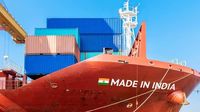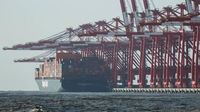As the global trade landscape shifts dramatically, Indian exporters are navigating a complex web of tariffs and trade negotiations that have emerged under President Donald Trump's administration. The recent imposition of a 26 percent reciprocal tariff on India has sent shockwaves through the shrimp export industry, with Coastal Corporation, one of India's leading shrimp exporters, announcing on April 9, 2025, that most of its U.S. buyers are willing to absorb the increased costs. This willingness, however, comes amid growing concerns about the broader implications of these tariffs on trade and economic growth.
Coastal Corporation, which has historically relied heavily on the U.S. market, is now exploring opportunities to expand its exports to China, Russia, and Canada. According to the company's latest annual report, the U.S. accounted for a staggering two-thirds of India's $7.4 billion seafood shipments in fiscal 2024. The company stated, "Our ongoing discussions with U.S. buyers suggest that the majority are willing to absorb the increased cost, ensuring continued demand and minimizing potential disruption in the near term." Despite this optimistic outlook, Coastal Corp's shares have plummeted by approximately 14 percent since the announcement of the tariffs.
In a parallel development, heightened trade tensions between the U.S. and China have led to significant disruptions in the Chinese export sector. Reports from the South China Morning Post revealed that some exporters are abandoning shipments mid-voyage to avoid the financial burden of the new tariffs. As of April 10, 2025, the number of containers shipped daily from China to the U.S. has dropped dramatically from 40-50 to just 3-6. An employee from a China-listed export firm noted, "We’ve halted all shipping plans from the Philippines, Vietnam, Indonesia, and Malaysia. Every factory order is halted. Anything that hasn’t been loaded will be scrapped, and the cargo already at sea is being re-costed." This situation underscores the precarious nature of global trade as tariffs escalate.
China's response to the U.S. tariffs has been swift, with retaliatory levies of 84 percent imposed on U.S. imports. On April 10, 2025, China's Commerce Ministry urged the U.S. to meet them "halfway" in an effort to resolve the escalating tensions. The ministry warned that these tariffs risked severely impacting the global economy but emphasized that "the door to dialogue is open." This sentiment reflects a growing recognition among international trade players that cooperation may be necessary to mitigate the fallout from the trade war.
Amid this turmoil, Indian exporters are finding some relief. The U.S. pause on a 27 percent tariff has been welcomed by Indian industries, as Union Minister for Commerce and Industry Piyush Goyal met with export promotion council heads on April 9 to discuss measures to monitor the reciprocal tariff impact. Exporters are optimistic that the current tariff rates could create a more level playing field, particularly with China's 125 percent duty on its goods. A textile exporter noted, "There is a return to some sort of normalcy. But, nothing is final yet. So, both the industry and the government should look at how India can improve its global trade effectively."
Ajai Sahai, Director General of the Federation of Indian Export Organisations (FIEO), expressed optimism that the ongoing U.S.-China trade tensions could lead to significant opportunities for India. He stated, "With Chinese imports facing 125 percent duty in most sectors, China will have no other option but to vacate the U.S. market." This shift could open doors for Indian exporters, particularly in sectors where China currently holds a significant market share, such as textiles and footwear.
However, the export community is also wary of potential challenges. Pankaj Chaddha, Chairman of the Engineering Export Promotion Council, warned that while the U.S. is the top destination for Indian engineering goods, exports may drop by $4 billion to $5 billion annually in the first year due to the trade disruptions. He emphasized the need for India to accelerate its efforts in securing trade agreements with the EU, UK, Canada, and the Gulf Cooperation Council (GCC) to cushion the impact of these changes.
In the recycling sector, the uncertainty created by Trump's tariff policies has raised alarms. The U.S. recycled materials industry, which supports nearly 600,000 jobs nationwide, is grappling with the potential fallout from new tariffs. The Recycled Materials Association warned that these tariffs would disrupt manufacturing and recycling processes that depend on recycled materials input. The industry is particularly concerned about the implications of tariffs on materials and equipment, which could further complicate their operations.
Plans for a major plastics recycling facility in Erie, Pennsylvania, were scrapped due to funding freezes by the Trump administration. Mitch Hecht, CEO of the International Recycling Group, expressed his dismay, stating, "I was personally devastated by the decision to cancel the plant, which was expected to create hundreds of jobs." The decision reflects the broader challenges faced by the recycling industry as it navigates the complexities of global trade.
Despite these challenges, some industry experts see a potential upside. If tariffs make raw materials more expensive, domestic markets for recycled materials could become more competitive. Shelie Miller, a professor at the University of Michigan, noted that while the market for metals remains strong, the recycling industry faces significant hurdles in competing against the costs of new plastics and glass. "There is almost always a good market for metals, because the cost to make new metals is incredibly high," she said.
As the U.S. and China continue to grapple with their trade relationship, Indian exporters and the recycled materials industry are adjusting to a new reality. The coming weeks will be crucial as negotiations unfold and the impact of these tariffs becomes clearer. The global economy is at a crossroads, and the decisions made in the near future will shape the landscape of international trade for years to come.






